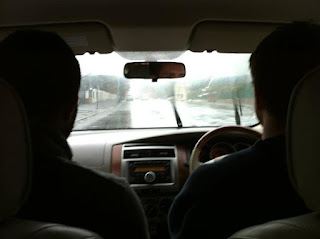I think we’ve been back for 36 hours. Maybe. And we left
Cape Town a little more than three days ago. I’m not really sure. All I know is
that I woke up at 7:30 this morning after 5 hours of sleep. So much for the
recovery period I was planning. No hibernating here in 90-degree heat. Suddenly
I’m kicking myself for counting down the days until the Baltimore heat. I’ve
unpacked a little. There’s a pile of dirty clothes on the floor in my
apartment’s entryway. It’s times like these I don’t really like being a grown
up in my own apartment. This whole unpacking process would be expedited if I
could roll my suitcase into my laundry room at home. Within a few hours my “Africa” clothes would be folded
neatly on top of the washer machine, awaiting their departure to the third
floor. Thanks, mom.
The 24 hour (!) travel period wasn’t nearly enough time to
digest everything that happened in Africa. We’re all definitely still wrestling
with the time difference and heat wave (I’m praying those bumps on my arm are a
heat rash and not bed bug bites). I know I am still trying to get acclimated to
Baltimore and life without my ten new friends. I would totally suffer through
another Graca Machel breakfast (and instant coffee) if it meant I could hear
Ling complain about the lunch ladies and watch Ndu shovel egg sandwiches in his
mouth. And as much as I’ve missed Blue Bell (my blue Honda Civic), I miss
Wayne’s gold speckled smile that he cracked even when we were running a little
late for our departure to work. I miss his spacious van that was always
mistaken for a mini bus taxi. I miss “Monday Mornings with Matt” on the rides
to work and how much everyone bonded in the car ride back and forth from their
internships. I miss the “judgment free zones” that seemed
to pop up everywhere with the ten of us. Somehow the rules of the Monday night
reflection circle were applied to Wayne’s van, Liv (our rental car), the
Oatlands, and even the couches of Cubana. So much was said and understood among
all of us that we were “all reflected out” on Friday night during our final
reflection session with Lisa and Angela. In the beginning of our trip (i.e. the
awkward van ride from Hopkins to Dulles), the silence may have been awkward,
but by our seventh and final Friday in Cape Town, the silence was comfortable.
It was so evident that we all had uniquely “heavy” experiences. We didn’t need
to talk about it.
 |
| With our driver, Wayne. Van not pictured. |
Now that I’m back in Baltimore, I’ve sunken to the bottom of
the “emotional curve” Angela handed out in the beginning of our trip. I thought
surely my “rock bottom” would have been when I opened up my lunch to discover a
quiche. Or that day when it was really cold, and rainy, and I didn’t know how
I’d be able to make it seven weeks with the same ten people (sorry, guys). Currently
I’m sweating in my apartment, wishing for the rain to break this heat wave.
And, honestly, I could go for a quiche.
 |
| Our rental cars with their respective drivers. Liv is the slightly cuter one on the right with Tyler. |
 |
| Liv expertly navigating the rough roads. |
Through this blog you’ve seen that we have had our share of
experiences and adventures in South Africa. We’ve experienced townships in both
Soweto and Langa, we’ve swam with sharks, we’ve jumped off bridges, we’ve
climbed up mountains, and explored every tourist attraction of Cape Town. We
learned as much about HIV/ AIDS that could be taught in six weeks and worked
part time at local NGO’s. However,
our individual journeys were more than what was written in this blog and more
than the pictures you see on Facebook. Words and pictures don’t seem to do
justice to the emotions we felt, the lessons we learned, and the ways we have
all grown as scholars and as world citizens.
 |
| One of our Monday reflection sessions. |
Thank you to the Public Health and Study Abroad Offices for
organizing the trip, the President’s Office for sponsoring our trip, and
parents as well as fellow students for reading our blog. A special thanks to my
family who supported my decision to skip town for the summer and then
respecting my privacy when I was on the other side of the world.
Time to finally do my laundry and finish unpacking.



































